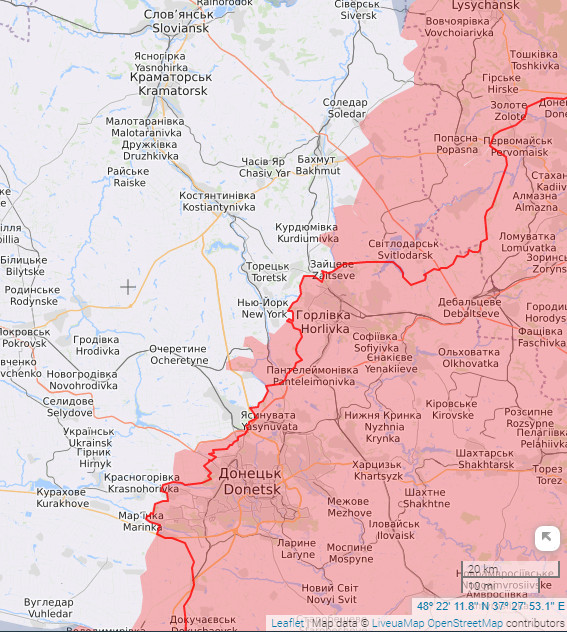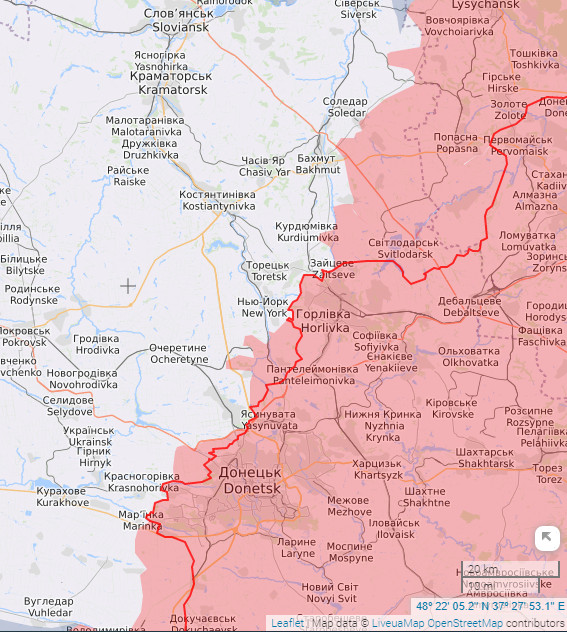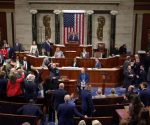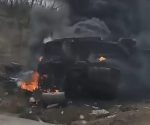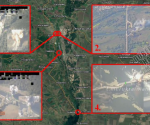The Russian partial mobilisation is but a component in what was always an inevitability
It was said before in this place that the Russians were systematists in their Special Military Operation, and so it’s actually not very surprising to see a partial mobilisation of 300,000 of Russian reservists coming hot on the heels of announcements on Novorossiyan referenda to accede to the Russian Federation, in Donetsk and Luhansk (or Lughansk as it should properly now be spelled), and in Kherson (with captured Mikolaiv) and Zaporozhye. It’s clear to see that the latter creates a requirement for the former, because it needs to be guaranteed. The author, then, is pretty certain that this has been a plan in the pipelines for a long time, and its execution conditional on the State of the SMO.
It’s no wonder that Mi7 in the UK is like an even more demented Rumpelstiltskin, at its propaganda looms furiously weaving nonsense, for instance, about the mass desertion of Russian men ahead of so-called “conscription”, because what actually appears to be the calling up of trained men already serving on a part-time or on a “serve-as-required” basis means that the Russians will, for the first time, come near to matching the Ukrainians in terms of manpower – although this is a very nuanced area, and being outnumbered is accommodated in Russian military doctrine. Be that as it may, the fact that Macron placed a panicking phone call to Putin – only to be denied – shows that the Collective West (or London, or the International Rules-based Order [NWO]), which Sergei Shoigu, the Russian Minister of Defence, as mobilisation was announced, recognised Russia to be at war with, knows what this development means, and is beside its frustrated, impotent itself.
In the last few days, the Russians and allies made significant gains in Donetsk, for example, but not only, as shown in the graphics below from liveuamaps, 25th and 26th September respectively.
While Russia might be detecting terminal Ukrainian weakness in Donetsk, the big determining factor that will have triggered the latest development has got to be the decimation of the Ukrainian “million-strong army” in the trap that was laid for it in Kharkov, and in its “war against the fields” in Kherson.
The following is from the previous FBEL article, and is supremely pertinent:
When one looks at the wider conflict, in the context of understanding why they haven’t… [created] pincers around the rear of the Ukrainians, one can now appreciate that the Russians may have had concerns about their manpower levels versus what the Ukrainians might amass to counter. Even so, now that the Ukrainians have spent much of that force (in Kherson and Kharkov), it’s probably unlikely that the Russians will change their head-on approach – not least because it is so successful at “demilitarising” Ukraine.
Also, the author has not changed his mind about this:
Indeed, the author is not inclined to believe that movement into other parts of Ukraine will happen until Donetsk is fully liberated from back to front, inching forward all the way, and in such a way as to take no risks.
The relief of Donetsk must be the priority – and the author is confident that Russia will use their escalation to bring this theatre to a resolution in the first instance. Then, as reckoned also in said previous piece:
When Russia pushes through Donetsk things will look very different and it will be much harder for Ukraine’s US/UK sponsors to convince people, be they leaders of European countries being asked to supply weapons or otherwise become further embroiled, or Ukrainians being asked to support their government, that Ukraine can win, or even compete in the conflict.
Given that this is being written a number of days after the event, the reader will surely know by now that a televised statement by Putin and a filmed interview of Shoigu were released around about the same time on 21st September, and both talked about the mobilisation with Putin also specifically linking it to the referenda. Absolutely clear in both addresses was the commitment to create a territorially complete Russian Donetsk: “It is necessary to consolidate the territory, to control it, and above all this is the purpose the work [partial mobilisation] is carried out for” – thus spake Shoigu.
If one is to take just one thing from Putin’s speech it must be his guarantee to Russian people – a grouping that, through the referenda, is soon to include the folk of four former Ukrainian territories – that the integrity of Russian land would be protected, and at all means at the Russian military’s disposal.
This declaration has since gathered Western propaganda clag in order to obliterate the message at its core, with US President Biden leading by example in a reaction that overemphasised and loaded other meaning to Putin’s warning aimed at himself and the likes of Liz Truss (the stupid woman recently selected in the ethnic and other equality-diversity minority/victim-group affirmatively actioned beauty pageant as has recently transpired otherwise known as a Tory leadership election). No more will be said about the use of nuclear weapons here – Russia certainly doesn’t need to use them in Ukraine, and the UK/US wouldn’t dare provoke Russia conventionally let alone with so-called unconventional arms‡.
The core message is that any Ukrainian force sitting on land declared to be Russian homeland will automatically convert into an occupying one, and face being driven out. As Putin said, “[the] main objectives [of the SMO] – the liberation of the entire territory of Donbass – were and remain unchanged”, but the difference in the alteration in the political status – which is the circumstance that will have changed – means that the Ukrainians will not be tolerated under any circumstances. The Ukrainians won’t be allowed to be present anymore.
This renders moot a certain hoo-ha occurring at the moment regarding the town of Krasny Liman – which all by itself, now that the Kharkov trap has snapped shut (with numbers of Ukrainian dead cited in certain quarters as ranging from 5,000 to 10,000), and the Kherson “war on the fields” finds its place in history – works as propaganda to create the appearance of Ukrainian fitness-to-fight. By the accounts of OSINT-mongers on Twitter and Telegram (and reported as a fact by some stars of so-called alternative media geopolitical analysis), this significant Donetsk town is currently suffering from a supposed relentless and determined Ukrainian attack. Be that as it may – not least because the author observes a running narrative produced by less than credible OSINT-monger sources – there is no reason to believe that Krasny Liman is under any threat of being taken by the Ukrainians and, crucially, not remaining taken for very long if such a thing does happen҂. There are several major Donetsk towns due to be liberated, and the referenda and mobilisation will make it certain that they will be.
Particular details of the partial mobilisation given by Putin and Shoigu confirm a reality that has been drummed into the FBEL audience for months, and also attests to the correctness of another more recent proposal made against the flow set by a gallery of alternative media so-called big name expertise. The 300,000 are specialists. Both Putin and Shoigu use the same terms denoting that this is the case. Again, this is not about putting infantry boots on the ground; it’s not about literally closing off the space between the shoulders of ranks of soldiery. If one has managed to catch the story of State Duma Deputy Milonov, a politician who was called up, it has an unsurprising denouement if one knows how the Russian armed forces are calibrated to fight: Milonov has become an artilleryman.
What the Russians have done, we can suppose, is enlarge the forces dedicated to Ukraine according to current proportions in order to wage artillery doctrine warfare in more places at once, or in greater depth when required. There’s also a matter of forming standard defence structures as the ex-Ukrainian territories come into the jurisdiction of homeland military. It’s definitely not about sending “grunts”. And although the glitterati of the alternative media geopolitical analysis scene want their audience to understand what happened in Kharkov as a defeat for the Russians, the truth is that in this conflict Ukraine hasn’t been able to move in any meaningful way unless the Russians have allowed them to do it† – and all with a fraction of the numbers now being made available. Hopefully, how the situation has just degenerated even further for the Ukrainians is something that is patently self-evident.
There was something in particular that Shoigu said about additional training that the reservists would receive [Putin: “taking into account the experience of the special military operation”] before being deployed that supports the apparent fact that the referenda and the then necessary mobilisation (and also, in actuality, before any of that the withdrawal from Kharkov to create the bounds of the annexation) has been planned for some time. Apparently, the timing is such that what appears to be pre-existing routine slots for training – or a usual teaching period, to help express the idea – has been given over to the reservists with the previously allocated usage being postponed. This is what the author gathered from watching Shoigu. It means that nothing is being done in a state of emergency. The events have been timed to coincide with a foreseen opportunity to ready the mobilised troops. Now, there is nothing in any of this to make the author change his mind that the ultimate trigger for the unfolding of these plans was the defeat of the so-called “million-strong army”, which Russian planners – and everyone else for that matter – knew was coming down the road not least because of statements issued in July, so that the BBC was able to publish an article entitled “Ukraine aims to amass ‘million-strong army’ to fight Russia, says defence minister”.
Mi7 (the BBC) might well have played it down – “the comments by Defence minister Oleksii Reznikov are being seen as more of a rallying cry than a concrete plan for a counter offensive” – but the Russians would have put two and two together to make four.
For the Russians, it seems, when the UK/US leadership (and such a thing is recognised) had smashed this resource against the rocks of Russian gunnery, the way ahead would be made much less uncertain. Indeed, Shoigu passes comment on the state of desperation reached in the progress of Ukraine’s own mobilisation project – now in its fourth iteration – and to paraphrase him: “they are recruiting from the train station to the beach”. They are rounding up anything they can find.
So, here is another reality about the mobilisation being carried out by both sides: it is Ukraine which is replacing losses, and still not being able to compensate, not Russia.
Shoigu puts the number of Russian dead at 5937, and there will be a little discussion about that shortly. The Ukrainians, he said, had lost 61,207 by death, and 49,368 by wounding. Without even accounting for the prisoners that Russia holds, this amounts to half of the Ukrainian armed forces, possibly not including gendarmerie and irregulars (this was not made clear), as had been available at the commencement of the conflict in February. Shoigu appeared to say that the Ukrainians had mobilised their own 300,000 as a total of their entire effort also since the beginning of the hostilities. Most of the best ones of these – at least as the Russians must be thinking – have been wiped out, along with the cream of the starting standing army. Therefore, the chances are good that the Ukrainians need to replace their skilled and specialist troops – a far cry from being able to produce additional ones, as the Russians are doing – and it appears to be the last thing that can be done if the bottom of the barrel has long been being scraped. This would then lead to a need for speciality soldiers of other nations in Ukrainian uniform; indeed, both Putin and Shoigu remarked upon the presence and influx of “a large number of Western instructors and curators”, which the latter said was in control of aspects of Ukrainian activity. Putin, for his part, explained that the “million-strong army” (featuring foreign “mercenaries”) had been “placed under the de facto command of Western advisors”. Although the ones higher up the hierarchy hide in Kiev, others are going to be vulnerable to the great leveller of Russian stand-off fire power, and this is why this conflict is really the most important thing in terms of making London insecure that is happening at the moment. The subject of just how many have succumbed to death in this conflict is something to be taken up in a later FBEL article.
As most who are following this conflict already know, the number for Russian dead will not have been accounting for the losses of the Lugansk and Donetsk forces. The author can find no information on this figure, but given that these people are the ones who have been in the greatest harm’s way for the longest, no one can imagine they are getting away scot free. However, the reader is asked to recall the fact of Russian stand-off firepower warfare, and the fact that this has been the modus operandi in the grind through Lugansk and Donetsk – which is why it is so methodical – and therefore high casualty claims for the Russian alliance in these places, as expressed in an FBEL piece dedicated to UK misrepresentation of such things, would by “[incongruous] to our understanding of a reality on the ground”.
In short, the author only has Russian numbers to deal with – but it’s enough to show that he was vindicated in dismissing the very high numbers of casualties that even “pro-Russian” alternative and social media (not surprisingly) were bandying about to echo claims of their corporate-media colleagues of up to 6,000 dead in the first weeks of the war.
The reader might recall that the “carnage”, according to the narrative, was due to very high, unbelievably high levels of success in the usage of anti-tank weaponry by the Ukrainians, explained where the author saw it being done, by “Russian armour… [running] into Ukrainian infantry screens” and generally by ambush.
However, what was being proposed was unfeasible, and there is further discussion of why that was the case in the FBEL article, The Russian Way of Warfare, from whence the following is extracted (it being pertinent to the argument being made):
The reader is asked to notice the reiteration of the prime mover in Russian doctrine with its accent on using artillery at long distances that frankly makes a mockery of grossly overinflated Ukrainian and US/UK corporation claims about Russian casualties. In truth, by their doctrine, the Russians have not put themselves at that risk – and this makes perfect sense when the execution of this same doctrine demands that non-artillery troops can be considerably outnumbered by the enemy.
It certainly would have been the Russian forces themselves, rather than any of their allies, who were running the gauntlet of the supposed challenges posed by supposed Ukrainian anti-tank super-heroism, because it was the Russians who executed the very mobile component at the opening of the conflict: Wikipedia itself names Russian groupings as doing this.
Therefore, all the data is in, and the lie is completely confirmed: with the number of Russians having been killed over the entire course of the war being the same as was claimed by the anti-Russian axis in March, the Ukrainians did not have the initial success that has already entered Anglo-globalist history. In fact, it was the first propaganda campaign in what would become a long line – all because the Ukrainians, never having been able to win a real military conflict against Russia, have only ever been able (no doubt being led at it by their UK masters) to pretend at it. Unfortunately for them, the ability to do this is going to become increasingly narrower, until the inevitable reality quashes all capability whatsoever. Some Russian politicians are looking for complete unconditional surrender. It remains to be seen what exact form the inevitable reality will take, but one thing is for sure: Ukraine is never reacquiring that lion share of its richest real estate that is about to join with Russia.
† Shoigu said that the “collective west” was using NATO and civilian satellite infrastructure to aid Ukraine by reconnoitring Russian troop positions. The author suspects the Russians used this to lure the NATO-led Ukrainian force into its Kharkov death rush.
‡ In bold in response to the errant claptrap being circulated on social media at the moment about American belligerent posturing and plans to intervene in Ukraine (that we somehow all of us now know about). For an antidote, please see:
With The Iranian Ballistic Missile Attack, America’s Millennium Challenge 2002 Experience Stops Being Virtual (link)
The Attack On The Yavorov International Peacekeeping And Security Centre; Part One: Without Thought Or Fear Of US/UK Retaliation (link)
҂ Update, 1st October, 2022:
The Russian Defence Ministry briefing for today states:
Massive fire attacks launched at the positions of 66th and 93rd mechanised brigades of the AFU have resulted in the elimination of over 200 Ukrainian servicemen, 5 tanks and 9 infantry combat vehicles.
Despite the suffered casualties and having a considerable superiority in forces and means, the enemy sent reserve forces and continued the offensive at this direction.
Due to the risk to be encircled, the allied forces were withdrawn from Krasny Liman to more advantageous frontiers.
First of all, in no sense of the word has Ukraine been able to “take” Liman: it doesn’t mean “to receive possession” or “to be given control”, taking always means a party actively acting. Often it means forcing another party to submit. To defend the sentence in the body of the article which reads “there is no reason to believe that Krasny Liman is under any threat of being taken by the Ukrainians” is not just arguing the toss about semantics, it’s about being absolutely clear about the meaning of events. And so that there is perfect clarity about which side suffered from the use of force, there will now be an FBEL article dedicated to examining Ukrainian losses suffered in trying to realise what was essentially a (short-sighted) grandiose public relations exercise.




